 Employee Communication Best Practices
Employee Communication Best Practices
What are the most effective internal communication channels available? We’re here to help you with the fundamentals and make sure you have a good mix.

.png)
Strategy is an important component of internal communications. Ensure you’re communicating through the right channels at the right frequency with our Internal Communications Channel Audit worksheet.
Access NowEffective internal communication is critical to any organization’s success. Selecting the best communication channels plays an integral role in facilitating this process. In 2025, evolving internal communication channels, both traditional and new, will continue to merge. This guarantees that organizations will have numerous attractive options for fostering employee engagement and maintaining effective internal communication.
But are the internal communication channels your organization uses adequate?
Gallagher’s 2025 Employee Communications Report examines internal communication channel satisfaction. Based on the findings and insights of the company’s State of the Sector 2024/25 survey, it analyzes who decides on the comms channel mix and whether it meets communicators’ requirements. According to the report, 51% of communicators retained the same channel mix they had in 2023. Only 7% removed channels. Of those who added a channel (31%), most said their motivation was “better meeting business needs.” Furthermore, communicators who added a channel were more satisfied with their channel mix across the board.

There’s a lot to think about. So, in this post, we’re going to give an overview. We will identify and discuss the most important internal communication channels that are likely to apply in 2025, and we will highlight their unique benefits and applications.
Internal communications channels are mechanisms that are used within organizations to facilitate a smooth flow of information. They enable leaders to share critical data, reach goals and deadlines, discuss upcoming projects, ask for and give feedback and keep the wheels of the organization turning. Each channel serves different purposes and may be designed to reach a specific target audience within the organization, depending on the platform.
Whether you are using a simple email template builder or a complex enterprise chat tool, the essence of all internal communications channels is to foster a culture of transparency, team engagement, and continuous improvement within an organization.
But, how are these channels significant in a workplace setting? Why do they matter?
Internal communication channel resources refer to the tools and platforms used to deliver messages across an organization, including email, intranet, mobile apps, video, and collaboration tools. Choosing the right mix of channels ensures messages are accessible, engaging, and aligned with employee preferences and communication goals.
Additionally, as Gallagher emphasizes, effective communication strategies require fit-for-purpose tools. But there is a caveat.
“Although most communicators influence channel decisions, dissatisfaction with current channel capabilities remains widespread. This is why it is so important to choose the right channels to meet your needs.”
Gallagher’s Employee Communications Report 2025
There is, of course, a clear distinction between formal and informal internal communication channels — planned meetings, letters, and strategy documents vs. spontaneous conversations via text messaging or social media and everyday chit-chat.
In a chapter titled Communication Channels (2024), in the International Encyclopedia of the Social & Behavioral Sciences, Hilde T.D. Moore points out that the target group and objective of a specific communication will determine which communications are relevant.
“For a short message telling someone your location for where to pick you up, a text message would be sufficient. There is no need to construct a formal document to convey this message. However, if the recipient does not know how to open or read a text message, a phone call might be a better option. For company guidelines, a written document would be a good alternative, as it can be handed out to new employees to inform them on expectations and responsibilities for the business, management, and employees.”
Another factor to consider is whether communication is synchronous, like emails and intranet, or asynchronous, which involves real-time interactions.
Returning to Gallagher’s 2025 report quoted above, it’s interesting to see how organizations rate the internal communication channels they have to use. Gallagher’s survey asked whether communicators had the right tools for the job. The percentage shown here indicates a favorable response:
The report also explores the effectiveness of internal communication channels compared to usage. This list highlights the channels with the most opportunity, where usage is low, but effectiveness is high.
This indicates that there are many opportunities that organizations and their leadership are missing.
Internal communication channels:
In essence, a strong internal communication channel strategy operates much like the nervous system of a body, maintaining the alignment of functions and the overall health of the organization. So the question remains, what channels should you use for your organization and how can you effectively utilize them?
Effective internal communication channels, both synchronous or asynchronous, face-to-face and digital serve as vertical and horizontal lines of communication that connect every corner of any organization. They promote collaboration and an unwavering workflow.
However, it can be both a challenge and a blessing to recognize that the boundaries between face-to-face, print, and digital communications continue to blur. For this reason, we are going to look at three broad types of communication channels and use this categorization to explore the 20 most important internal communication channels.
Upgrade your company’s internal comms to enhance employee communication
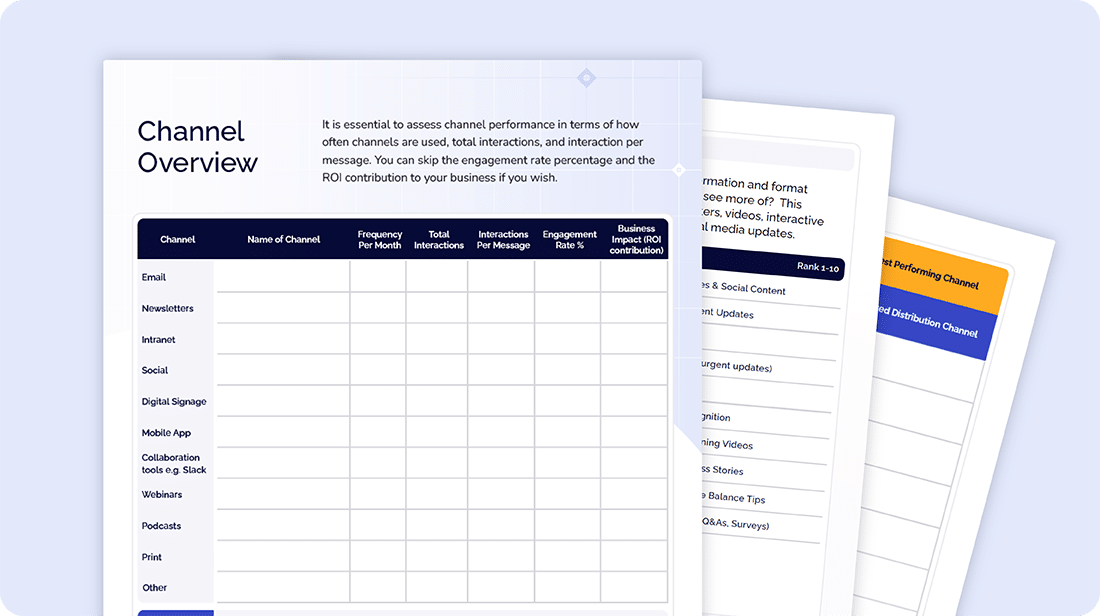
Broadcast channels are receptive internal communication channels that push information to the workforce as a whole, regardless of their geographic location or work patterns. They are all excellent for sharing the latest company news and important information.
Gallagher found that the broadcast channel used most is email, with 92% using email announcements from companies to employees and 84% using email announcements that appear to come from a leader. They state that these are 80% and 78% effective, respectively.
An email is still the primary internal communication channel. Despite the rise of social media and instant messaging, emails remain a standard for all kinds of external and internal communications, both formal and informal. Also, with the rise of email template builders, the ability to create, send, and track email analytics has become much easier — and considerably more effective.
According to Statista, in 2024, 347,3 billion emails were sent and received daily worldwide. They reckon that by 2027 this figure will increase to an incredible 408.2 billion emails.
E-newsletters serve as a reliable internal communication channel for keeping employees in the loop about company updates. A fortnightly or monthly employee newsletter can include everything from project updates to employees’ personal accomplishments.
According to Gallagher, company e-newsletters are 75% effective and used by 65% of companies.
Face-to-face or virtual town halls enable real-time interaction and encourage open dialogue. Despite the rise of remote work, this format has evolved by integrating video conferencing software such as Zoom or Microsoft Teams.
Gallagher found that the most effective company-to-employee comms are employee in-person (87%), However, they are only used by 52% of companies.
Video is a powerful medium for sharing big-picture messages and engaging employees. It’s especially useful for sharing training materials or tutorials and can be shared via internal channels like the intranet or internal social media platforms.
According to Gallagher, leader videos to employees are 79% effective, but are only used by 48%.
Web conference calls provide a platform for collaborative discussions and decision-making processes. Meetings can be held via platforms like Skype, Zoom, or internal software tools that allow optimal participation and interaction.
Environmental channels such as posters, banners, and notice boards can be strategically placed in high-traffic areas within the office. This helps relay important messages, reminders, or updates to the team members.
Digital signage is another powerful visual tool that can engage staff in the workplace. It can display everything from company news to relevant industry updates and more. They are especially useful for deskless workers.
Despite the move towards digitalization, traditional letters, and other printed messages remain relevant for communicating significant announcements. They’re often seen as more personal because they are imbued with a sense of importance or formality.
At the same time, traditional printed or handwritten letters aren’t used much any more — only 12% according to Gallagher. Generally, organizations seem to limit their use to formal announcements, legal notices, or personalized, one-to-one communications. Nevertheless, they are 53% effective when used.
Direct text messages are useful for communicating important, time-sensitive information or reminders. This channel sees high response rates given the ubiquitous nature of mobile devices.
According to Gallagher, text and WhatsApp messages from the company are 75% effective, but only used by 12%.
An employee magazine, whether printed or produced as a digital publication, can be an engaging way to keep the workforce informed of internal developments. For digital editions, you can easily сreate a PDF online to share via email or an intranet. It can include varied content, including company news, employee interviews, and spotlights on departments or long-standing employees. The trick is to choose content that employees will value, read, and share.
Gallagher’s finding is that digital employee magazines are 74% effective, but only used by 12%. Printed magazines are used by 10% and are less effective (53%).
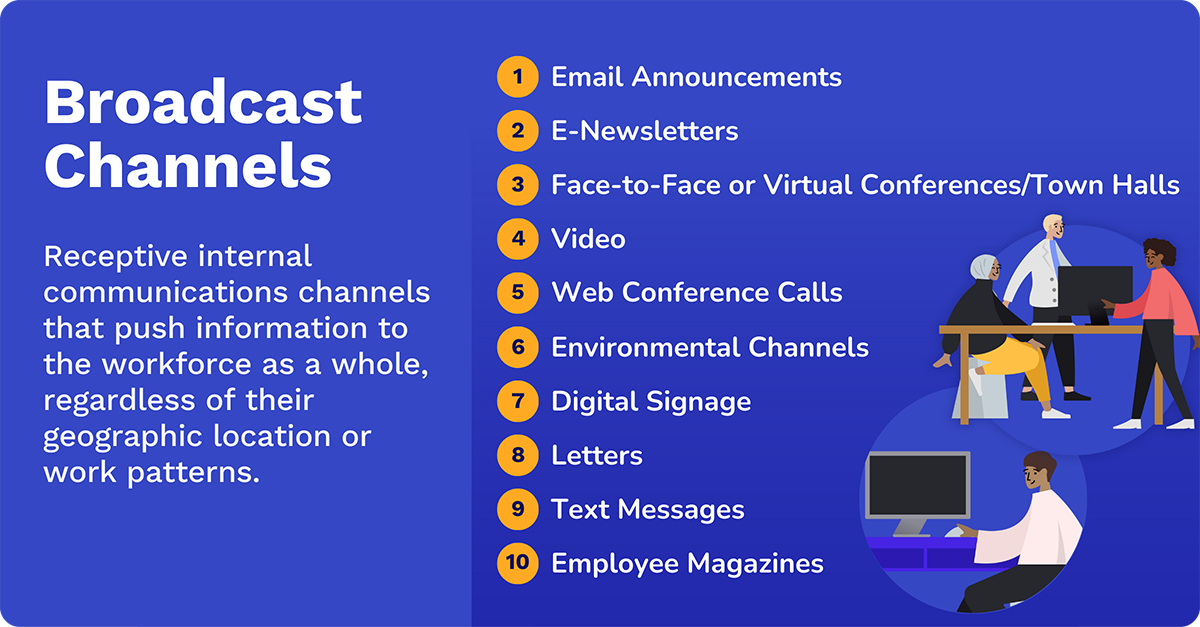
Collaboration and interpersonal channels focus on communication between different individuals or groups within an organization. These create an atmosphere of collaboration and belonging, promoting transparency and engagement.
Regular team meetings foster open dialogue and engagement between team members and their managers. They are fundamental to the team structure, promote unity, and overcome silos.
Tools like Slack, MS Teams, or Google Hangouts facilitate real-time discussions and document sharing, boosting team collaboration. They can greatly improve internal communications, especially for remote teams.
Informal water cooler chats stimulate ingenuity and camaraderie in the workplace. Despite their impromptu nature, they serve as opportunity moments for gatherings, nurturing creativity and innovative ideas.
Employee resource groups aggregate employees with shared attributes or experiences. They foster understanding, support leadership development, and enhance employee engagement.
Identifying and deploying ambassadors or communication champions enables peer-to-peer communication. These people will spearhead communication efforts, effectively distributing information and voicing employee feedback.
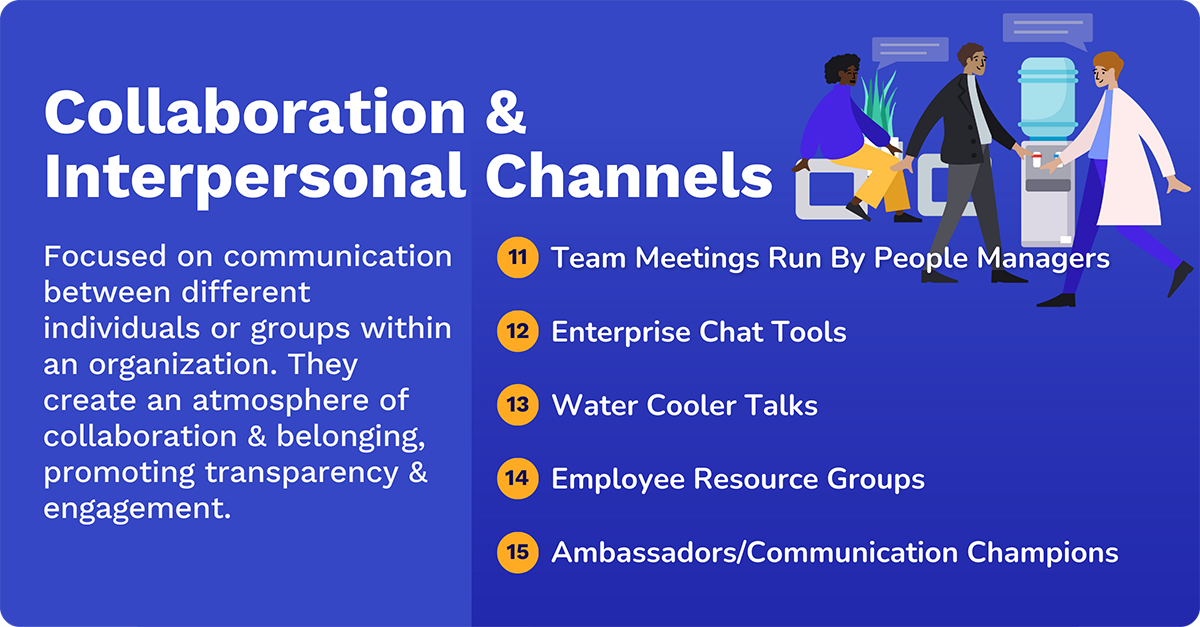
Self-serve channels empower employees to choose when and how they receive information. They give independence and flexibility to the workforce while ensuring that key information is readily available.
Apps simplify the flow of information and allow employees to tailor their access to company communications. Notifications ensure that no one misses out on important updates and the interfaces are generally user-friendly and intuitive.
An employee portal can involve a range of services including HR information, project management tools, and an internal blog. These offer employees a one-stop shop for all their informational needs.
Intranet systems act as the internal internet for companies, hosting a host of resources and tools for the employees. They can include announcements, employee directories, document sharing platforms, and more.
Internal podcasts are becoming a popular medium for companies to communicate with their remote workforce. Employees can listen to them at their convenience, making them a great tool for time-shifted communication. However, while Gallagher reports that leader podcasts are 64% effective, they are only used by 9%.
AI-driven chatbots can be set up to offer immediate responses to employee queries around the clock. They improve employee experience by providing instant access to information and support.
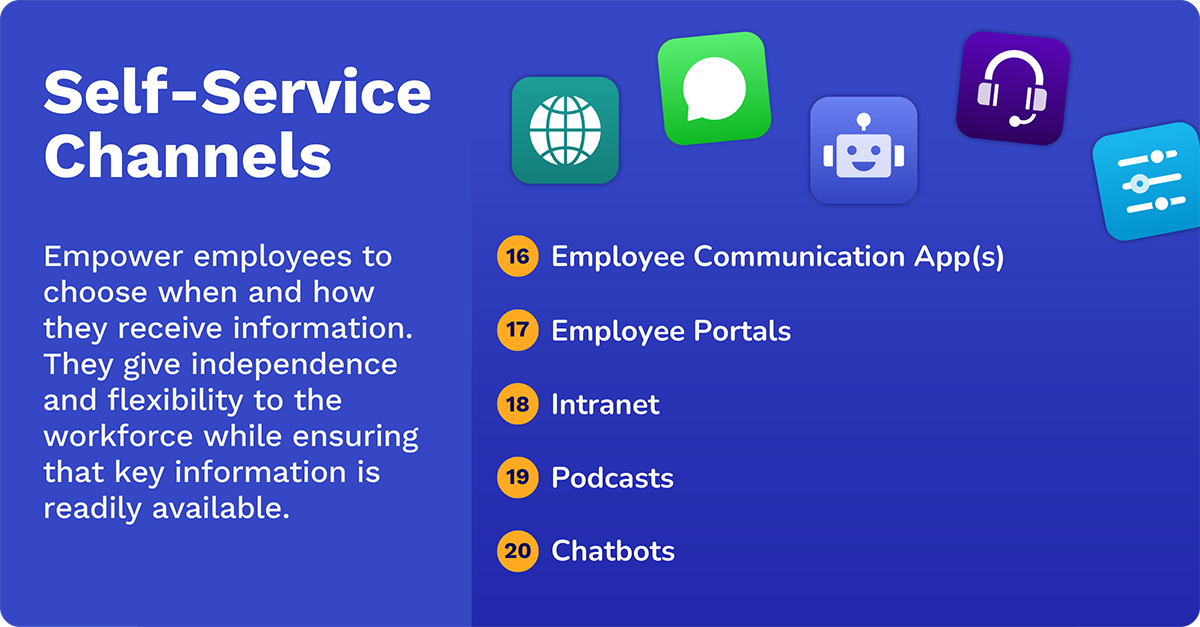
Choosing the right mix of your internal communication channels strategy can dramatically influence organization functionality. Recognizing your audience, assessing its needs, evaluating your resources, and taking stock of your limitations and strengths are all keys to designing a robust internal communications channel strategy.
When setting up such a strategy, it is important to first identify your key audiences and what information they need to do their jobs. This will allow you to determine which communication channels will best reach and impact each employee group.
The channels you opt for should enable two-way dialogue so employees can provide feedback and ask questions. It is also hugely helpful to have an editorial calendar that outlines what types of company news and updates will be shared across the various platforms and with what frequency. But, it appears these are underused.
Another invaluable tool for assessing the impact and efficacy of communication channels is data. However, Gallagher’s survey found that less than 10% of organizations are using data to make changes to their channel framework. Similarly, less than 10% are using data to inform an audience-specific content approach. At the same time, 73% respondents agreed that it was important to use data to evaluate channel frameworks.
It’s also important to realize that an organized approach prevents communication overload. To achieve this, designate specific staff members to be responsible for developing content and monitoring engagement for each channel. By intentionally selecting channels, messaging, and teams, companies can build an impactful internal communications channel strategy that meets their business goals.
“Amongst the wealth of data we have, we need to choose the information that matters most to leaders. All the other stuff we need to keep for ourselves. Don’t overwhelm people with numbers.”
Internal communicator quoted by Gallagher
Upgrade your company’s internal comms to enhance employee communication

Effective communication is crucial for organizations. The most efficient way to achieve this is by choosing the right internal communication channels that align with organizational objectives and employee preferences. Though it is rather impossible to point out an optimal mix of channels that would fit any organization, as each entity is unique, this section will help to guide choices and increase understanding of the specifications and applicability of each channel.
A significant initial step when selecting the internal communications channels to use involves a keen understanding of the purposes and characteristics of the channels.
Let’s look at some primary internal communications channel attributes in more detail:
Since every organization is different, striving for the perfect mix of channels can involve some experimentation. It’s important to start small and scale up. The best way to do this is by using email analytics, employee surveys, and feedback from managers to evaluate usefulness and effectiveness.
No single channel can deliver all types of communication 100% effectively. This means certain occasions will dictate the use of certain channels over others. For instance:
It’s important to remember that communication channels don’t stand alone. Rather, they are components of a larger system. A well-thought-out internal communications strategy recognizes the unique contributions each channel can make in facilitating communication.
Choosing the right mix of channels is as much an art as it is a science. A good mix not only facilitates effective internal communication but also serves to boost employee engagement, foster a positive employee experience, and ultimately, lead your organization to success
You can enhance your internal communication channel strategy effortlessly with Cerkl Broadcast, our intelligent audience management platform designed for personalization and performance. With features like Email Blasts for timely, targeted updates and automated News Digests tailored to individual preferences, Broadcast empowers you to reach employees where and how they prefer to engage. Segment audiences with precision, schedule communications for maximum impact, and leverage built-in analytics to continuously refine your strategy.
Unlock the full potential of your communications using tools such as email performance insights, email analytics, employee surveys, and manager feedback. Evaluate the effectiveness of your current methods and ensure alignment with organizational goals to build a connected, high-performing workforce.
Our dedicated Cerkl team is here to support you in building a communication plan that boosts engagement and drives results. Start by requesting your free communication audit to assess the impact of your existing strategy and identify opportunities for improvement.
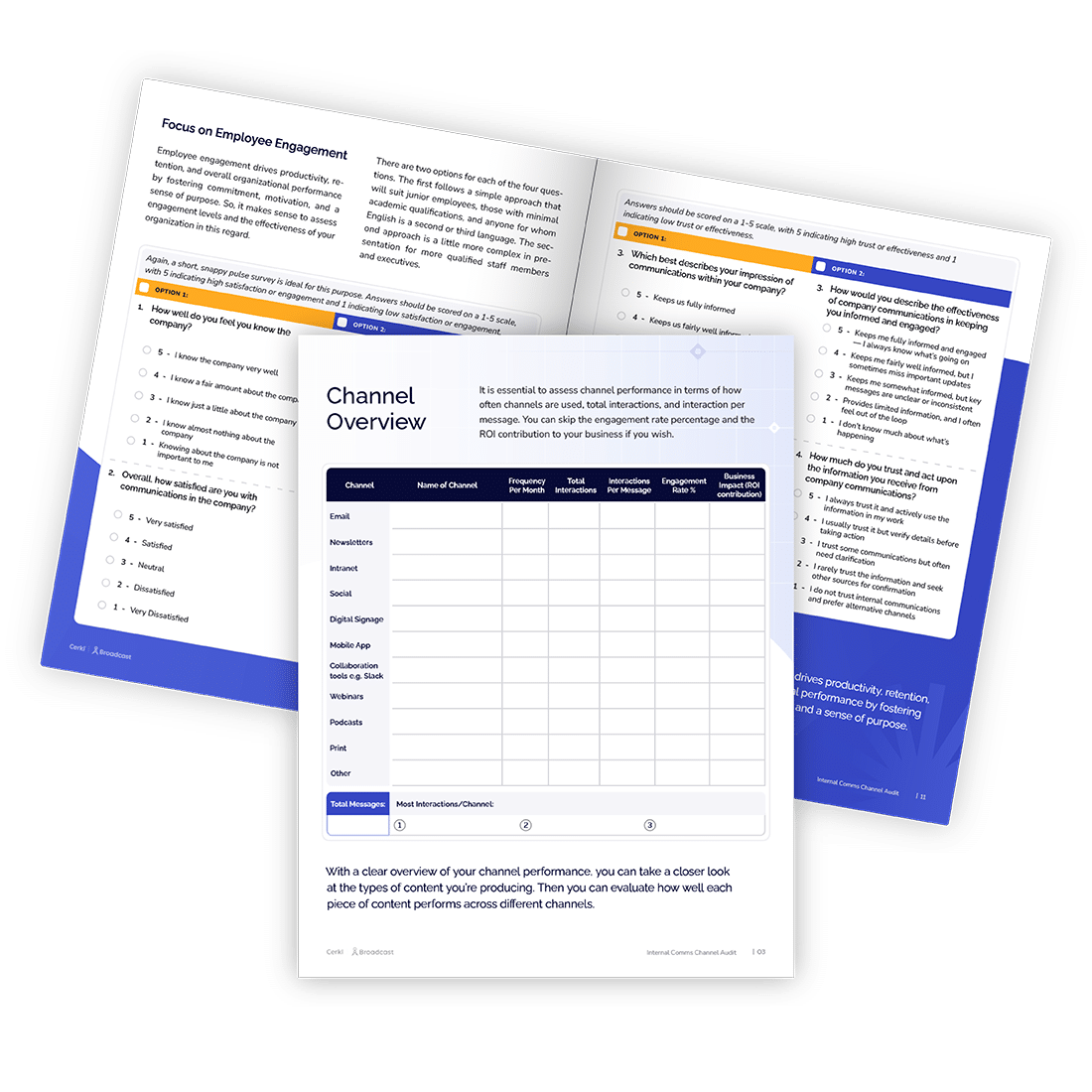
Upgrade your company’s internal comms to enhance employee communication
What are internal communication channels? Internal communication channels are the various means through which we exchange information within an organization. They include many well-known methods including email, intranet, on-site or digital meetings, and a variety of messaging platforms.
What are the types of internal communication? Types of internal communications include formal channels like official memos and reports, and informal channels such as team meetings, social media platforms, and water cooler conversations. Together, they form an internal communication channel strategy. All of these are capable of fostering both top-down and bottom-up communication, including vertical and horizontal comms.
What are the 3 channels of communication within an organization? The three internal communication channels within an organization typically include:
- Upward communication from employees to management
- Downward communication from management to employees
- Lateral communication between colleagues or departments.

Upgrade your company’s internal comms to enhance employee communication